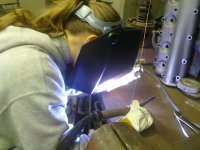evanthayer
Aluminum
- Joined
- Jun 13, 2018
I am interested in learning TIG welding in the Bay Area. The options for learning welding for a non-career welder are limited to 1 artsy, over-priced school in Oakland (The Crucible) and a number of community colleges with certificate courses that are for career seeking students.
I am very motivated to learn and am interested in getting 1-on-1 training during the work-week at my shop or someone else's shop at whatever the right hourly rate is. How would one go about finding a situation like this? Are their welders out there who would (a) be interested in something like this and (b) have the interest and character to want to teach someone?
Thoughts welcome!
I am very motivated to learn and am interested in getting 1-on-1 training during the work-week at my shop or someone else's shop at whatever the right hourly rate is. How would one go about finding a situation like this? Are their welders out there who would (a) be interested in something like this and (b) have the interest and character to want to teach someone?
Thoughts welcome!



 )
)